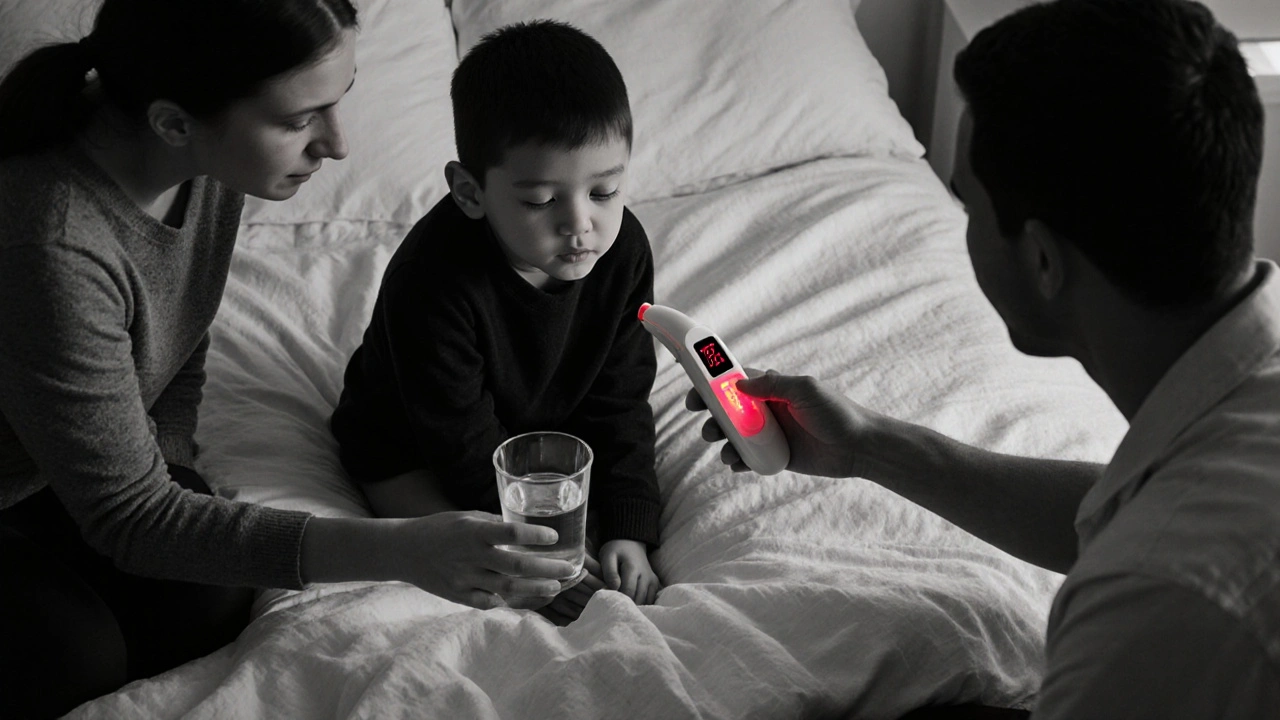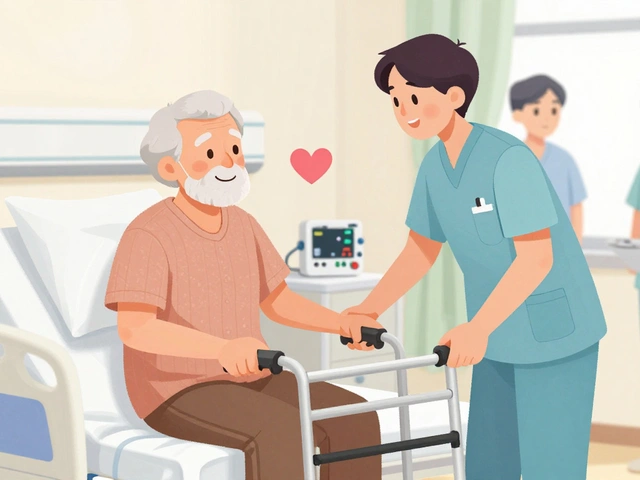When a temperature climbs above normal, many people jump to alarm mode-Fever is an elevation in body temperature that often signals the body is fighting something off. In reality, a fever is usually a helpful part of the healing process, not a disaster waiting to happen. Below we break down the most persistent fever myths and give you the facts you need to stay calm and care for yourself or a loved one.
Key Takeaways
- A fever is a symptom, not a disease, and it helps your body combat infection.
- Most fevers don’t require medication; they resolve on their own.
- Only very high temperatures or specific risk groups need urgent medical attention.
- Understanding the cause of a fever is more important than the temperature reading alone.
- Common myths-like “fever always means a serious illness”-are largely unfounded.
What Exactly Is a Fever?
Normal body temperature hovers around 36.5°C(97.7°F) but can vary by a half‑degree throughout the day. A fever is typically defined as a core temperature of 38°C(100.4°F) or higher. The rise is driven by the immune systemthe network of cells and chemicals that defend the body against pathogens, which releases signalling proteins called cytokinesmolecules that coordinate the body’s response to infection and inflammation. These cytokines tell the brain’s hypothalamus to reset the thermostat, producing a higher temperature that makes it harder for bacteria and viruses to replicate.
Myth #1: A Fever Means the Body Is “On Fire”
Many picture a fever as a literal flame raging inside you. In truth, the body isn’t burning; it’s simply turning up the heat. Think of it as a fever‑ish sauna that speeds up metabolic reactions, helping white blood cells work faster.
Myth #2: All Fevers Must Be Treated with Medicine
Over‑the‑counter antipyretica drug that reduces fever, such as ibuprofen or acetaminophen can provide comfort, but they aren’t always necessary. If the fever is mild (under 39°C/102.2°F) and the person is drinking fluids, resting, and eating light foods, the body will often bring the temperature down on its own.
Myth #3: A High Fever Is Always Dangerous
Dangerous fevers-those above 40°C(104°F)-are relatively rare in healthy adults. The real concern is prolonged fever (lasting more than 3days) or fever in vulnerable groups like infants, the elderly, or immunocompromised patients. In those cases, a doctor’s evaluation is wise.
Myth #4: You Can Feel a Fever Without Measuring It
Subjective feelings-chills, sweating, headache-can suggest a fever, but they’re not reliable. A thermometera device that measures body temperature, ranging from digital sticks to infrared forehead models provides the only accurate confirmation. Even a quick oral or ear reading is more trustworthy than a “feel‑it” guess.

Myth #5: Fever Is Only Caused by Infections
While infections (bacterial, viral, fungal) are the most common triggers, other factors can raise body temperature: inflammatory diseases (like rheumatoid arthritis), heat‑related illnesses (including heat strokea severe condition caused by overheating, often in athletes or outdoor workers), certain medications, and even vaccines can spark a short‑lived fever.
Myth #6: Fever Means You’re Contagious
Not every fever signals a contagious illness. Viral infections are typically contagious, but bacterial infections like urinary tract infections may not spread. A fever caused by an internal inflammatory condition (e.g., lupus flare) isn’t contagious at all. Knowing the underlying cause is key.
Myth #7: Kids With Fever Should Always See a Doctor
Parents often panic when children develop a fever. In most cases, a child’s fever is a sign of the body fighting off a minor viral infection. However, infants under three months with any fever, or children who show signs of dehydration, persistent vomiting, or a rash, need prompt medical attention.
Myth #8: You Should Cool a Fever‑ish Child with Icy Water
Applying ice or cold baths can cause shivering, which actually raises core temperature. Instead, use lukewarm sponges, keep the room comfortably cool, and dress the child in light clothing. Comfort is more important than dramatic temperature drops.
Myth #9: Fever Always Indicates a Serious Illness Like Sepsis
Sepsis is a life‑threatening response to infection that can cause fever, but it’s accompanied by other red flags: rapid breathing, confusion, low blood pressure, and a rapid heart rate. A simple fever without these systemic signs is unlikely to be sepsis.

Myth #10: Once the Fever Breaks, the Illness Is Gone
When the fever subsides, you might feel better, but the underlying infection can still be present. Continue to monitor symptoms, stay hydrated, and finish any prescribed antibiotics to ensure the pathogen is fully cleared.
Quick Myth‑Fact Reference Table
| Myth | Fact |
|---|---|
| Fever means the body is “on fire”. | It’s a controlled rise in temperature to help immune cells work faster. |
| All fevers need medication. | Many mild fevers resolve without drugs; comfort measures often suffice. |
| High fevers are always dangerous. | Only fevers above 40°C (104°F) or prolonged fevers in vulnerable groups pose serious risk. |
| You can feel a fever without measuring. | Only a thermometer gives an accurate reading. |
| Only infections cause fever. | Inflammatory diseases, heat‑stroke, certain meds, and vaccines can also raise temperature. |
| Fever always means you’re contagious. | Only certain infections are contagious; inflammatory fevers are not. |
| All kids with fever need a doctor. | Most children’s fevers are benign; see a doctor for infants <3months or concerning symptoms. |
| Ice baths are the best way to reduce fever. | Lukewarm sponges and light clothing are safer and more effective. |
| Fever always signals sepsis. | Sepsis includes additional signs like rapid breathing, low blood pressure, and confusion. |
| When fever breaks, the illness is gone. | Symptoms can linger; continue care and finish any prescribed treatment. |
How to Manage a Fever at Home
- Check the temperature with a reliable thermometer. Record the reading.
- Encourage fluid intake-water, oral rehydration solutions, or clear broth. Dehydration worsens fever symptoms.
- Offer light meals such as toast, bananas, or rice. Heavy foods can overload the digestive system.
- Dress in breathable, lightweight clothing. Over‑bundling traps heat.
- Keep the room temperature around 20‑22°C (68‑72°F). Use a fan if needed.
- If the fever exceeds 39°C (102.2°F) and the person feels uncomfortable, consider a single dose of an antipyretic. Follow dosage guidelines.
- Monitor for red‑flag symptoms: difficulty breathing, persistent vomiting, rash, confusion, or a temperature above 40°C (104°F). Seek medical help immediately.
When to Call a Healthcare Professional
Even though most fevers are harmless, certain scenarios demand professional evaluation:
- Infants younger than 3months with any fever.
- Fever lasting longer than 3days without improvement.
- Severe headache, stiff neck, or sensitivity to light-possible meningitis signs.
- Rapid heart rate, rapid breathing, or low blood pressure (possible sepsis).
- Underlying chronic conditions (e.g., heart disease, diabetes) that could worsen with fever.
Bottom Line
Understanding the why behind a fever demystifies the experience. Most fevers are simply the body’s natural defense, and they rarely require aggressive treatment. Keep an eye on the temperature, stay hydrated, and know the warning signs that call for medical help. Armed with the facts, you can calm your own nerves and those of anyone you’re caring for.
Frequently Asked Questions
What temperature qualifies as a fever?
A core temperature of 38°C (100.4°F) or higher is generally considered a fever. Measurements can be taken orally, rectally, tympanically, or with a forehead infrared device.
Should I always give my child medication for a fever?
Not necessarily. If your child is comfortable, drinking fluids, and the fever is below 39°C (102.2°F), you can monitor without medication. Use an antipyretic only if they appear uncomfortable or the fever climbs higher.
Can dehydration worsen a fever?
Yes. Fever raises the body’s water loss through sweating and faster breathing. Staying hydrated helps the body regulate temperature more effectively.
When is a fever a sign of something serious like sepsis?
Sepsis usually presents with fever plus rapid breathing, a fast heart rate, low blood pressure, confusion, or extreme fatigue. If you notice these alongside a fever, seek emergency care.
Are there natural ways to lower a mild fever?
Yes. Rest, cool (not cold) compresses, a lukewarm bath, light clothing, and staying hydrated can all help the body cool down without medication.



peter derks on 15 October 2025, AT 22:31 PM
Great breakdown! The article does a solid job reminding us that a mild fever is actually a sign the immune system is active. I love the tip about using lukewarm sponges for kids instead of icy baths – that’s a real game‑changer. Staying hydrated and resting are often enough to let the body do its thing. Keep sharing these practical pointers, they help a lot of people stay calm when a temperature spikes.